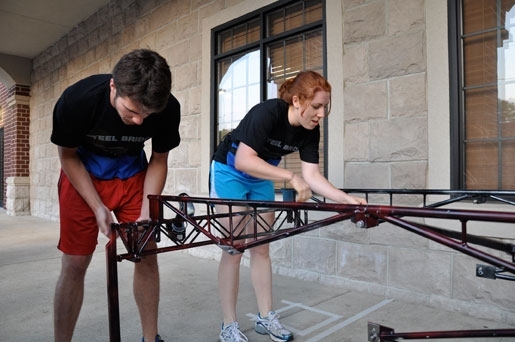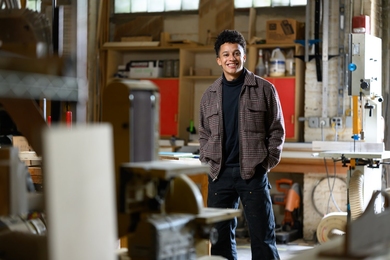The regionally top-ranked MIT Steel Bridge Team placed sixth at the national competition at Purdue University May 29, an extraordinary feat for a young team of undergraduates in its fourth year of participation. MIT ranked first among private universities.
Participants in the competition were required to design a 21-foot bridge that can be assembled quickly (the top speed this year was 3 minutes, 12 seconds) and withstand loads of 2,500 pounds with little deflection or sag. While the design rules change annually, all bridge pieces must fit into small boxes (about 3.5 feet long), and during construction, each team member is allowed to enter only certain portions of the staging area and to hold only one bridge piece at a time. This requires team members to pass pieces from hand to hand, relay-race style, as they construct the bridge.
The students’ success this year is due largely to their enthusiasm, willingness to put in late nights and their ability to work well under deadline pressure. Another very important factor was their bridge design, which benefitted from the work of Pierre Ghisbain, a graduate student advisor to the team whose area of research is earthquake engineering and structural optimization. The Department of Civil and Environmental Engineering (CEE) awarded Ghisbain the Trond Kaalstad (Class of 1957) Fellowship for his voluntary efforts working with the team.
“My specialty is optimization, and the whole competition is really about optimization, so I decided to jump in,” said Ghisbain, who had no prior experience in bridge design, but was very familiar with engineering design software.
Read more: http://cee.mit.edu/news/releases/2010/steel-bridge
Participants in the competition were required to design a 21-foot bridge that can be assembled quickly (the top speed this year was 3 minutes, 12 seconds) and withstand loads of 2,500 pounds with little deflection or sag. While the design rules change annually, all bridge pieces must fit into small boxes (about 3.5 feet long), and during construction, each team member is allowed to enter only certain portions of the staging area and to hold only one bridge piece at a time. This requires team members to pass pieces from hand to hand, relay-race style, as they construct the bridge.
The students’ success this year is due largely to their enthusiasm, willingness to put in late nights and their ability to work well under deadline pressure. Another very important factor was their bridge design, which benefitted from the work of Pierre Ghisbain, a graduate student advisor to the team whose area of research is earthquake engineering and structural optimization. The Department of Civil and Environmental Engineering (CEE) awarded Ghisbain the Trond Kaalstad (Class of 1957) Fellowship for his voluntary efforts working with the team.
“My specialty is optimization, and the whole competition is really about optimization, so I decided to jump in,” said Ghisbain, who had no prior experience in bridge design, but was very familiar with engineering design software.
Read more: http://cee.mit.edu/news/releases/2010/steel-bridge






